Are you a Quiet Speculation member?
If not, now is a perfect time to join up! Our powerful tools, breaking-news analysis, and exclusive Discord channel will make sure you stay up to date and ahead of the curve.
Today I will venture away from the realm of MTGO speculation to a specific type of spec that works only for physical cards (for now at least): the preorder spec. Preordering a card is easily one of the highest variance bets you can make. No one has gotten a great chance to actually see the new cards in action and they can fluctuate wildly from their initial valuations.
Today I'll go over some of the great past specs and try to determine if there are any patterns we can discern. My methodology will be as follows. I will go through the MTGGoldfish data for physical cards from the last seven sets and pick all of the cards that increased in price either 400% or by $15 within the first two months after release (in relation to the price at release).
These are the slam dunk preorder picks. I choose such extreme qualifications for a few reasons. First, it ensures that they are truly profitable specs, even after all frictions are taken into account. It's easy to feel good about a physical spec that "doubled" from $2 to $4, but after all is said and done you may be close to breaking even when you take into consideration shipping, fees, and the time needed to make all of the sales.
Second, a spec that is so wildly underpriced at release is much more likely to be due to a giant misevaluation by the Magic community than due to luck or variance. This means there is a chance we can find the secret ingredients that lead to such amazing specs. On to the cards!
Slam Dunk Picks of the Past
Oath the Gatewatch
- Kalitas, Traitor of Ghet ($6.5 to $23)
Battle for Zendikar
- None
Magic Origins
- Jace, Vryn's Prodigy ($19 to $44)
- Hangarback Walker ($2 to $17)
Dragons of Tarkir
- Dragonlord Ojutai ($9 to $33)
- Den Protector ($1.5 to $9)
Fate Reforged
- Outpost Siege ($0.5 to $4)
- Mastery of the Unseen ($0.8 to $4)
Khans of Tarkir
- Monastery Swiftspear ($0.5 to $2.5)
- Dig Through Time ($2.3 to $12)
Magic 2015
- Goblin Rabblemaster ($1 to $11)
Honorable Mentions
These are some of the cards I noted in my analysis that fell just short of qualifying as a slam dunk spec. They were either just short of 400%, just short of +$15, or spiked just after the initial two month period.
Ingredients for a Great Preorder Spec
Based on the above specs, I'll try to list some patterns I've noticed in the cards.
1) Priced Low for its Rarity
If we discount Jace, which is surely an outlier, then an uncommon spec should be no more than $0.5, a rare spec should be no more than $2, and a mythic spec should be no more than $10. I think this is a good baseline when looking for a greatly mispriced preorder spec.
2) Highly Flexible (Mana Cost)
Flexibility is key to a great spec because it means a card can fit into multiple different decks.
Hangarback Walker is to me the epitome of a flexible card. Its colorless mana cost allowed it to be played in so many decks that at one point on MTGO it achieved 40% metagame dominance (equivalent to four copies in 40% of decks). Hangarback was additionally flexible in-game since its XX mana cost made it great on turn two as well as turn ten.
3) Can Take Over a Game on its Own
Great cards become pillars of the metagame because they minimize the amount of effective counterplay that can be used against them. They often do this by "taking over a game."
An unanswered Jace or Rabblemaster is well known for stealing a game on its own. Another form of this concept is with cards like Dragonlord Ojutai that narrow your opponent's options because they are difficult to interact with (hexproof when untapped plus drawing you into more ways to protect itself).
4) Doesn't Need Help to be Good (Strategic Flexibility)
This is another form of flexibility as mentioned in point 2). The only difference here is that we're talking about a strategic flexibility as opposed to a flexibility in mana costs.
Lightning Bolt will be great in many different strategies regardless of the other cards surrounding it. Hedron Crab, on the other hand, can be fantastic in certain decks and useless in others. Its power is highly related to the cards that are around it so I would rate it very poorly in this category relative to a card like Lightning Bolt.
5) Will Be Played as a Four-of
The above four concepts feed into this once since if they score well in 1) through 4) you will likely want to play as many copies in your deck as you can. A lower casting cost also makes it easier to fit many copies of a card into a deck.
This isn't always the case, though, for example Dragonlord Ojutai was almost always played as a four-0f in Esper Dragons because it was extremely powerful and highly synergistic with the rest of the deck.
6) Complex and Therefore Difficult to Evaluate Blind
I think this is may be the key marker of a slam dunk spec. Why was Dig Through Time preordering at times for only $2 dollars when it was good enough to be banned in Legacy? The answer is it was hard for players to evaluate just how easy it was to pay the delve cost.
I know personally that Jace, Vryn's Prodigy and Hangarback Walker never stood out to me as broken cards until I actually played against them. It only took a few games on the other side of the table to realize that they were going to be Standard all-stars. Why was it so hard for me to realize ahead of time? I think it's because they are extremely complex cards that have a lot of things going on all at once.
If you are looking for the next slam dunk spec you should ask yourself: Why is this card great and why won't the average Magic player be able to figure it out?
SOI Cards with Slam Dunk Potential
Now let's try to apply the concepts above to the current Shadows over Innistrad (SOI) spoilers. The following are the cards that have a shot in my mind of being an eventual slam dunk as I have defined in this article. I'll give them a rating of poor, average, or good in each of the six attributes outlined above.
Note that I'm basing these specs off of the current SCG preorder prices on 3/24 as I am writing this article.
Always Watching
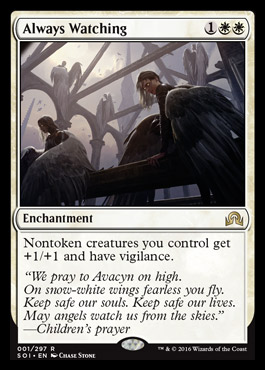
Price: $2
1) Poor; 2) Poor; 3) Poor; 4) Poor; 5) Good; 6) Average
Giving all of your creatures +1/+1 and vigilance is a powerful ability, but the mana cost is quite narrow and it only works with non-token creatures. Overall I don't think this is a great spec.
Descend upon the Sinful
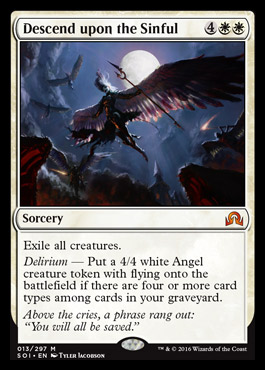
Price: $5
1) Good; 2) Average; 3) Good; 4) Poor; 5) Poor; 6) Average
I think this is reasonable spec, although not an amazing one. I can see the card being worth $10-$15 in the future if things go well (if delirium is easy to obtain and a six-mana wrath is where you want to be).
Geralf's Masterpiece
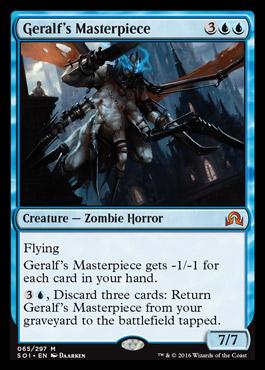
Price: $5
1) Good; 2) Good; 3) Good; 4) Poor; 5) Good; 6) Good
I like this spec. It is well-priced and does something that is potentially powerful and certainly very complex. Being able to cast a 7/7 flying at instant speed from your graveyard is powerful, although it certainly comes at a steep price.
Goldnight Castigator
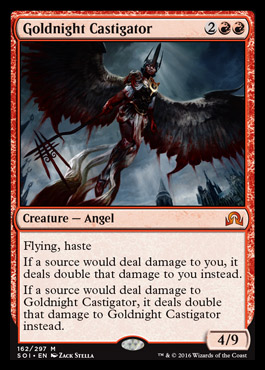
Price: $5
1) Good; 2) Average; 3) Average; 4) Good; 5) Good; 6) Good
I like this card, although it will be bad against certain matchups, most notably burn. I think a 4/5 flying haste is always going to be a powerful card in Standard. $5 dollars seems like a reasonable price. Assault Formation anyone?
Sinister Concoction
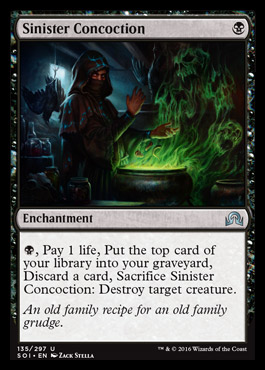
Price: $0.25
1) Good; 2) Good; 3) Poor; 4) Good; 5) Average; 6) Average
Two mana to kill any creature is certainly a great rate, especially when the mana can be spent over two turns. In decks that can take advantage of the discard, it may even be better than "BB: Destroy target creature," for example in a reanimator deck.
Cheap removal has always been great---it's just a matter of whether or not it's worth the card disadvantage. Since Path to Exile fell into a similar category, I think this card will be great, although I am never excited about an uncommon spec.
Fevered Visions
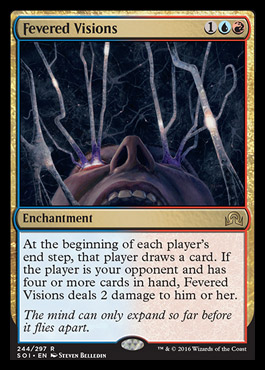
Price: $1
1) Good; 2) Poor; 3) Good; 4) Poor; 5) Good; 6) Good
I really like this card. Howling Mine is generally a powerful effect, and this one tacks on a sort of Sulfuric Vortex as well as drawing you the first card (which is atypical). The card is quite narrow however since it will only fit into blue-red decks that want to play on a resource other than cards. Overall an average spec in my opinion.
Pious Evangel
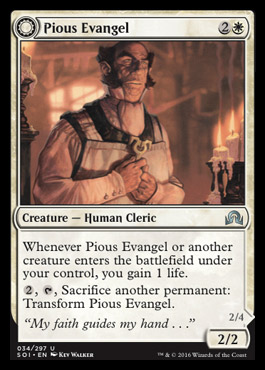
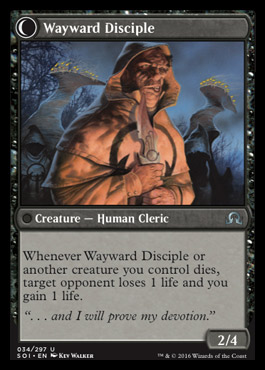
Price: $0.25
1) Good; 2) Good; 3) Poor; 4) Poor; 5) Good; 6) Good
With the move towards more creature-centric decks in Standard, I find the Soul Warden effect to be quite strong. The flip side of this card is even stronger and has been put to great use in current Standard in the Rally deck. Overall, though, I think it is likely not a great spec.
Topplegeist
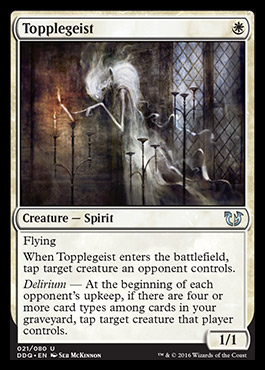
Price: $0.25
1) Good; 2)Good; 3) Poor; 4) Poor; 5) Good; 6) Good
A card that's hard to evaluate and reasonably priced. As with all delirium cards, however, it is quite narrow strategically and therefore I don't see it as an amazing spec.
Rattlechains
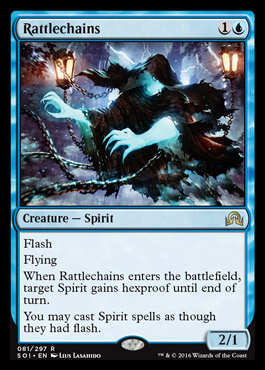
Price: $2
1) Average; 2) Good; 3) Poor; 4) Poor; 5) Good; 6) Average
This card's power will depend a lot on what other spirits it has to work with. Overall a very powerful but narrow card. I am not sold on this spec.
Deathcap Cultivator
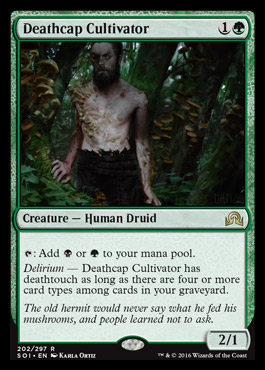
Price: $2
1) Average; 2) Good; 3) Poor; 4) Good; 5) Good; 6) Poor
A very straightforward card. It provides mana fixing and acceleration which have historically been great in Standard, although the last one many of us remember was Sylvan Caryatid, which is likely miles better than the Cultivator. Overall I think this is a safe spec, but I am not very excited about it.
Ulvenwald Hydra
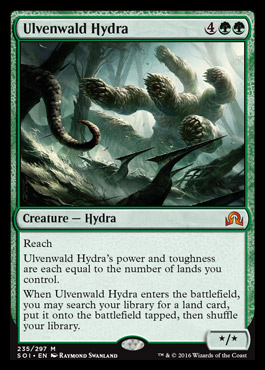
Price: $3
1) Good; 2) Average; 3) Average; 4) Good; 5) Average; 6) Average
The thing I love most about this spec is that it's a $3 mythic that will likely fit into every green EDH deck. I picked up 40 copies off of SCG for $3 dollars each as soon as I saw the card spoiled. I'm interested to see how it turns out.
In the best case scenario it finds its way into a Standard ramp deck that gets you two turns closer to Ulamog, the Ceaseless Hunger when you find Shrine of the Forsaken Gods. Certainly unlikely to be a slam dunk spec, but has some nice casual qualities to it which are always super relevant for non-digital cards.
Conclusion
If I had to rank the current three specs from SOI most likely to be slam dunks they would be:
- Goldnight Castigator ($5)
- Geralf's Masterpiece ($5)
- Descend upon the Sinful ($5)
Keep in mind that physical speculation is not my specialty, although I have been right (lucky?) in the past on preorders. Dragonlord Ojutai and Goblin Rabblemaster come to mind. I hope you are all having as much fun with this spoiler season as I am! As always, thanks for reading, and let me know your own personal thoughts on preorders in the comments.
Song of the Week: Elder - Lore (Heavy Metal)
Enjoy!


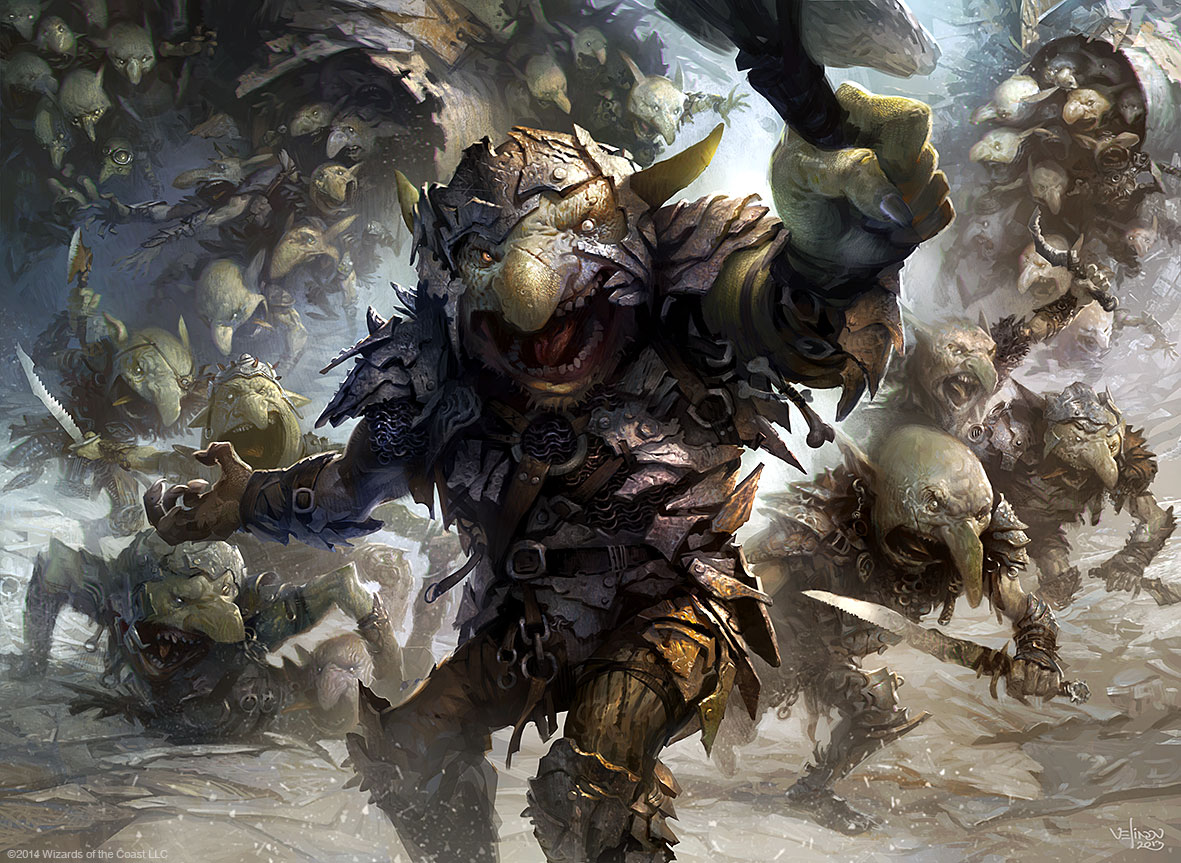



I really like the Goldnight Castigator pick and preordered a playset – mainly because I play mono red and I can see this being a 4 of if the deck moves more towards mid range with the loss of swiftspear (although it competes with thunderbreak which is another rotation spec).
I’m turning my attention to mtgo spec and for paper I’m just interested in getting what I need to play before price spikes. Being in the UK, the lack of a market as liquid as the US makes paper specs too costly to transact. At $5 for a playable mythic can’t go that wrong.
I think it’s great to speculate on cards that fit into your preferred archetype because you are more likely to judge the card correctly. It does suck that it competes with Thunderbreak, but that just gives it even more room to grow when DTK and ORI rotate.
There have already been a couple authors saying good things about Castigator. I just read an article dedicated to it by Sperling and PV wrote about it as well.
I love how great this card is against planeswalkers, which are poised to make a comeback when the format slows down.
I think that this is a great compliment to your last article. I’m not sure how objective your six criteria for each card is, but until actual statistical analysis is conducted to discover how each facet of a card (such as CMC, color identity, flexibility, metagame, set number, etc.) affects price I think these are decent rules of thumb that I have seen discussed in other places.